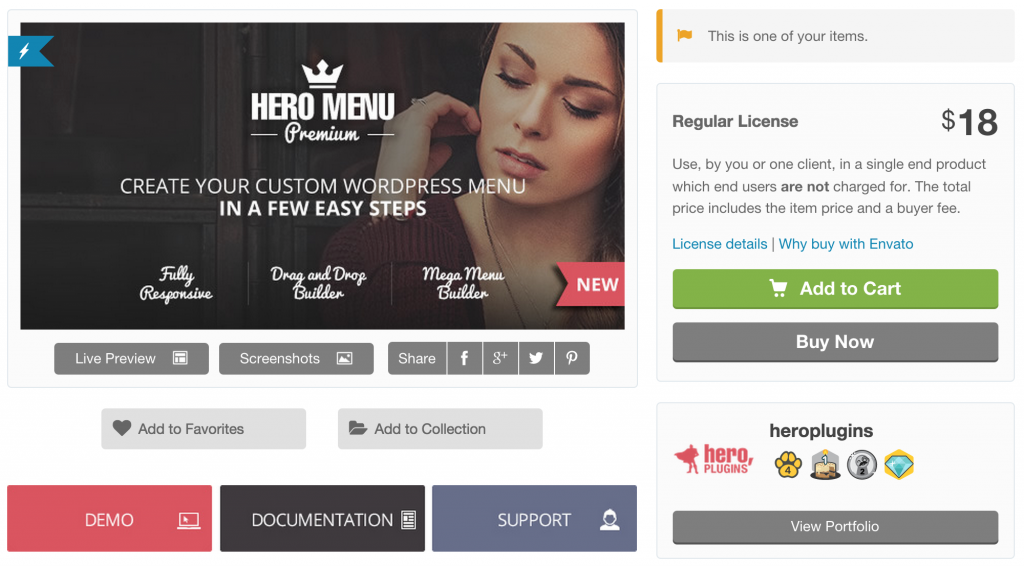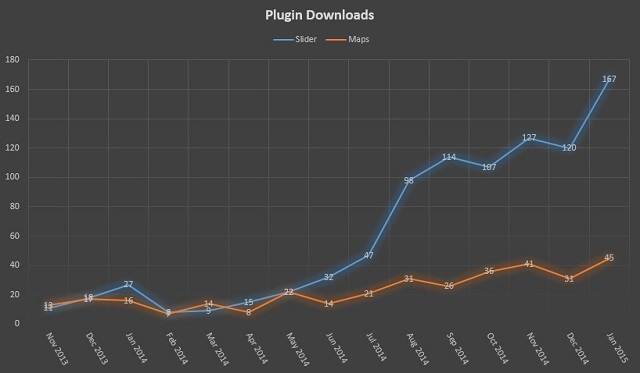
If you consider that we distributed our first two plugins through this website, you might wonder why we made the decision to distribute our plugins through CodeCanyon and WordPress. This post covers some of the reasoning behind the decision.
The WordPress market – for both themes and plugins – probably isn’t quite saturated just yet, but competition is fairly intense. We’re a late entrant into the market, and standing out in the crowded market can be challenging at best if you’re new and lacking the benefits bestowed by a known brand.
In the year following our initial launch, we saw a steady increase in the number of downloads, and HeroSlider was approaching the one thousand download mark before we discontinued the plugin. HeroMaps was a slow starter, but we saw a slight upwards trend with that plugin too.

But it seemed pretty clear from the start that entering into the market with a new premium product was not going to be easy or worthwhile unless there was a huge marketing push behind it, in which case it would take much longer for the venture to break even.
Below are the four main reasons behind our decision, which will hopefully help you decide if you should ever find yourself needing to make the same choice:
Search visibility
If you use any kind of generic plugin related term when searching in Google, chances are that CodeCanyon and WordPress plugin repository pages will dominate the first page of results. But it is also likely that the majority of people searching for plugins aren’t using Google in the first place – they are probably performing searches on WordPress and CodeCanyon.
Exposure to an established user-base
Following on my previous point – both WordPress.org and CodeCanyon.net have a massive – and established – userbase. While I generally do not trust Alexa scores as far as I can toss one of Google’s datacenters, the fact is that websites ranked in the top 1,000 earn a vast amount of traffic, and at the time of writing CodeCanyon was ranked just above the 400 mark. WordPress ranks even better, although not all its traffic is plugin related.
Payment logistics
Selling on your own means you need to be very conscious of all the related security considerations, payment gateways, and a myriad of other concerns I’m probably not even aware of. Selling via CodeCanyon removes all those worries and leaves room for things like staying on top of support and developing your next awesome plugin. The majority of buyers are also aware of this, and can purchase plugins with confidence.
Ease of delivery
If you’re a conscientious developer, you’ll be staying on top of keeping your plugin up to date, adding improvements and fixing the odd bug that crops up (and they do!!). While updating the plugin – regardless of where it’s hosted – is straightforward enough, it helps the user a great deal if they can simply update through their admin panel, and CodeCanyon as well as WordPress takes care of this detail.
Of course, nothing stops any developer from building a framework that takes care of this, and this is something we have in place for point version updates, but submitting your plugin to the two repositories takes care of this if you’re not in a position to do so.
And there you have the major reasons for working through those platforms. There are, of course, arguments against using platforms like CodeCanyon, with the two biggest ones being:
- Not having any control over the pricing of your product
- CodeCanyon takes a rather large percentage of your earnings as commission (50% at the start)
If you’re new to the arena, however, I believe the benefits outweigh the downsides – especially if you have a small team.
All of the above leaves us room to focus building great products and provide top-notch support. Whether we plan to move back to selling plugins through our own site again in the future is a subject for another post.
